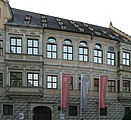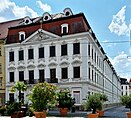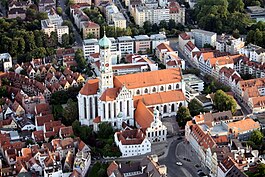
A | B | C | D | E | F | G | H | CH | I | J | K | L | M | N | O | P | Q | R | S | T | U | V | W | X | Y | Z | 0 | 1 | 2 | 3 | 4 | 5 | 6 | 7 | 8 | 9
Augsburg
Ougschburg (Swabian) | |
|---|---|
|
From top: Perlachturm (left); Augsburg Town Hall (right); Maximilian Museum; Fuggerei; Schaezlerpalais; Augsburg Cathedral
and Basilica of SS. Ulrich and Afra | |
| Coordinates: 48°22′08″N 10°53′52″E / 48.36889°N 10.89778°E | |
| Country | Germany |
| State | Bavaria |
| Admin. region | Swabia |
| District | Urban district |
| Government | |
| • Lord mayor (2020–26) | Eva Weber[1] (CSU) |
| Area | |
| • City | 146.84 km2 (56.70 sq mi) |
| Elevation | 494 m (1,621 ft) |
| Population (2022-12-31)[2] | |
| • City | 301,033 |
| • Density | 2,100/km2 (5,300/sq mi) |
| • Metro | 885,000 |
| Time zone | UTC+01:00 (CET) |
| • Summer (DST) | UTC+02:00 (CEST) |
| Postal codes | 86150–86199 |
| Dialling codes | 0821 |
| Vehicle registration | A |
| Website | www |
Augsburg (UK: /ˈaʊɡzbɜːrɡ/ OWGZ-burg,[3] US: /ˈɔːɡz-/ AWGZ-,[4] German: [ˈaʊksbʊʁk] ⓘ; Swabian German: Ougschburg) is a city in the Bavarian part of Swabia, Germany, around 50 kilometres (31 mi) west of the Bavarian capital Munich. It is a university town and the regional seat of the Regierungsbezirk Swabia with a well preserved Altstadt (historical city centre). Augsburg is an urban district and home to the institutions of the Landkreis Augsburg. It is the third-largest city in Bavaria (after Munich and Nuremberg), with a population of 304,000[5] and 885,000 in its metropolitan area.[6]
After Neuss, Trier, Worms, Cologne and Xanten, Augsburg is one of Germany's oldest cities, founded in 15 BC by the Romans as Augusta Vindelicorum and named after the Roman emperor Augustus. It was a Free Imperial City from 1276 to 1803 and the home of the patrician Fugger and Welser families that dominated European banking in the 16th century. According to Behringer, in the sixteenth century it became "the dominant centre of early capitalism", having benefited from being part of the Kaiserliche Reichspost system as "the location of the most important post office within the Holy Roman Empire" and the city's close connection to Maximilian I.[7] The city played a leading role in the Reformation as the site of the 1530 Augsburg Confession and the 1555 Peace of Augsburg. The Fuggerei, the oldest social housing complex in the world, was founded in 1513 by Jakob Fugger.
In 2019 UNESCO recognised the Water Management System of Augsburg as a World Heritage Site because of its unique medieval canals and water towers and its testimony to the development of hydraulic engineering.[8]
Geography
Augsburg lies at the convergence of the Alpine rivers Lech and Wertach and on the Singold. The oldest part of the city and the southern quarters are on the northern foothills of a high terrace, which has emerged between the steep rim of the hills of Friedberg in the east and the high hills of the west. In the south extends the Lechfeld, an outwash plain of the post ice age between the rivers Lech and Wertach, where rare primeval landscapes were preserved. The Augsburg city forest and the Lech valley heaths today rank among the most species-rich middle European habitats.[9]
Augsburg borders the nature park Augsburg Western Woods - a large forestland. The city itself is also heavily verdant. As a result, in 1997 Augsburg was the first German city to win the Europe-wide contest Entente Florale for Europe's greenest and most livable city.
Suburbs and neighbouring municipalities
Augsburg is surrounded by the counties Landkreis Augsburg in the west and Aichach-Friedberg in the east.
The suburbs of Augsburg are Friedberg, Königsbrunn, Stadtbergen, Neusäß, Gersthofen, Diedorf.
Neighbouring municipalities: Rehling, Affing, Kissing, Mering, Merching, Bobingen, Gessertshausen.
History

Early history

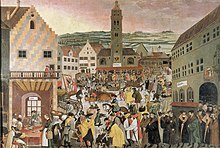
The city of Augsburg was founded in 15 BC on the orders of Emperor Augustus.[10] Emperor Augustus conducted extensive military campaigns and established administrative settlements. The Roman colony that became Augsburg was known as Augusta Vindelicorum, meaning "the Augustan city of the Vindelici".[11] The settlement was established at the convergence of the Alpine rivers Lech and Wertach. In 120 AD Augsburg became the administrative capital of the Roman province of Raetia.[12] Augsburg was sacked by the Huns in the fifth century AD, by Charlemagne in the eighth century and by Welf I, Duke of Bavaria in the 11th century.[citation needed]
Augsburg Confession
Augsburg was granted the status of a Free Imperial City on 9 March 1276 and from then until 1803, it was independent of its former overlord, the Prince-Bishop of Augsburg. Frictions between the city-state and the prince-bishops were to remain frequent however, particularly after Augsburg became Protestant and curtailed the rights and freedoms of Catholics. With its strategic location at an intersection of trade routes to Italy, the Free Imperial City of Augsburg became a major trading centre.[citation needed]
Augsburg produced large quantities of woven goods, cloth and textiles. Augsburg became the base of two banking families that rose to great prominence, the Fuggers and the Welsers. The Fugger family donated the Fuggerei part of the city devoted to housing for needy citizens in 1516, which remains in use today.[13]
In 1530, the Augsburg Confession was presented to the Holy Roman Emperor at the Diet of Augsburg. Following the Peace of Augsburg in 1555, after which the rights of religious minorities in imperial cities were to be legally protected, a mixed Catholic–Protestant city council presided over a majority Protestant population; see Paritätische Reichsstadt.[14]
Leading European centre of capitalism of the sixteenth century

Augsburg's economic boom years occurred during the 15th and 16th centuries thanks to the bank and metal businesses of the merchant families Fugger, Welser and Hochstetter. These families held a near total monopoly in important industries. Monopolies were considered criminal in contemporary laws and these families' practices were criticised by Martin Luther himself, but as Emperor Charles V needed their financial assistance, he cancelled the charge in the 1530s.[15][16] In the 16th century Augsburg became one of Germany's largest cities. Augsburg was a major manufacturing centre for textiles, armor, scientific instruments, as well as gold- and silver-smithing. The prolific printers of Augsburg also made the city the largest producer of German-language books in the Holy Roman Empire. Like other free imperial cities, Augsburg was an independent entity, and had authority over its tax policies.[17]
Augsburg's wealth attracted artists seeking patrons. The city rapidly became a creative centre for sculptors and musicians. Augsburg became the base of the Holbein family, starting with Hans Holbein the Elder. The composer Leopold Mozart was born and educated in Augsburg.[18] Rococo became so prevalent that it became known as "Augsburg style" throughout Germany.[citation needed]
Augsburg benefitted majorly from the establishment and expansion of the Kaiserliche Reichspost in the late 15th and early 16th century. This postal system, which was the first modern postal service in the world, was created through negotiations and agreements between the Taxis family represented by Franz von Taxis and the early Habsburgs monarches, notably Maximilian I, his son Philip the Handsome and grandson Charles V.[19][20] Even when the Habsburg empire began to extend to other parts of Europe, Maximilian's loyalty to Augsburg, where he conducted a lot of his endeavours, meant that the imperial city became "the dominant centre of early capitalism" of the sixteenth century, and "the location of the most important post office within the Holy Roman Empire". From Maximilian's time, as the "terminuses of the first transcontinental post lines" began to shift from Innsbruck to Venice and from Brussels to Antwerp, in these cities, the communication system and the news market started to converge. As the Fuggers as well as other trading companies based their most important branches in these cities, these traders gained access to these systems as well (despite a widely circulated theory which holds that the Fuggers themselves operated their own communication system, in reality they relied upon the imperial posts, presumably from the 1490s onwards, as official members of the court of Maximilian I).[21]
Witch hunts
Several witch hunts occurred in Augsburg in the late 16th century. Following the 1585–1588 plague epidemic, southeast Germany was shattered by the 1589–1591 witch hunts. Following the 1592–1593 plague epidemic, cities in southeast Germany entered a period of inflation, marked by brutal witch hunts in urban areas.[22]
Thirty Years' War
Religious peace in the city was largely maintained despite increasing tensions up to the Thirty Years' War (1618–1648). In 1629, the Holy Roman Emperor Ferdinand II issued the Edict of Restitution, which restored the legal situation of 1552. However, the edict was revoked in April 1632, when Gustavus Adolphus of Sweden occupied Augsburg.[citation needed]
In 1634, the Swedish army was defeated at the nearby Battle of Nördlingen. By October 1634, Catholic troops had surrounded Augsburg. The Swedish army refused to surrender and a siege ensued through the winter of 1634/35 and thousands died from hunger and disease. During the Swedish occupation and the siege by Catholic troops, the population of the city was reduced from about 70,000 to about 16,000. Diseases such as typhus and the plague ravaged the city.[23]
Guilds
In the first half of the 17th century Augsburg was pivotal in the European network of goldsmiths. Augsburg attracted goldsmith journeymen from all over Europe and in the 18th century a large number of silversmiths and goldsmiths became master craftsman in Augsburg.[24]
Nine Years' War
In 1686 the Holy Roman Emperor Leopold I formed the League of Augsburg, also known as the "Grand Alliance" after England joined in 1689. The coalition consisted at various times of Austria, Bavaria, Brandenburg, England, the Holy Roman Empire, the Electorate of the Palatinate, Portugal, Savoy, Saxony, Spain, Sweden, and the Dutch Republic. The coalition was formed to defend the Electorate of the Palatinate and fought against France in the Nine Years' War.[citation needed]
End of Free Imperial City status


The Reichsdeputationshauptschluss or the Final Recess of 1803, saw the annexation of nearly all of the 51 Free Imperial Cities, excepting Augsburg and five others. However, when the Holy Roman Empire was dissolved in 1806, Napoleon encouraged his German allies to annex their smaller neighbours, and Augsburg lost its independence. It was annexed to the Kingdom of Bavaria. In 1817, the city became an administrative capital of the Oberdonaukreis, then administrative capital in 1837 for the district Swabia and Neuburg.[citation needed]
Industrial revolution
During the end of the 19th century, Augsburg's textile industry again rose to prominence followed by the machine manufacturing industry.[citation needed]
Second World War and Cold War
Augsburg was historically a militarily important city due to its strategic location. During the German re-armament before the Second World War, the Wehrmacht enlarged Augsburg's one original Kaserne (barracks) to three: Somme Kaserne (housing Wehrmacht Artillerie-Regiment 27); Arras Kaserne (housing Wehrmacht Infanterie Regiment 27) and Panzerjäger Kaserne (housing Panzerabwehr-Abteilung 27 (later Panzerjäger-Abteilung 27)). Wehrmacht Panzerjäger-Abteilung 27 was later moved to Füssen.
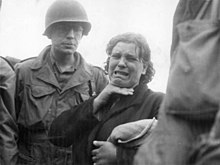
The MAN factory at Augsburg was the largest German manufacturer of engines for U-boats in World War II and became the target of the Augsburg Raid. When the Avro Lancaster bomber was new in service, the RAF sent 12 at low level to bomb the factory in daylight, on 17 April 1942. The bombers were intercepted en route and only five returned, all damaged. The factory was damaged but production continued; the factory was repeatedly bombed later. A subcamp of the Dachau concentration camp outside Augsburg supplied approximately 1,300 forced labourers to local military-related industry, especially the Messerschmitt AG military aircraft firm, headquartered in Augsburg.[25][26]
In 1941 Rudolf Hess, without Adolf Hitler's permission, secretly took off from a local Augsburg airport and flew to Scotland, crashing in Eaglesham, to the south of Glasgow. His objective was to meet the Duke of Hamilton in an attempt to mediate the end of the European front of World War II and join sides for the upcoming Russian Campaign.
The Reichswehr Infanterie Regiment 19 was stationed in Augsburg and became the base unit for the Wehrmacht Infanterie Regiment 40, a subsection of the Wehrmacht Infanterie Division 27 (which later became the Wehrmacht Panzerdivision 17). Elements of Wehrmacht II Battalion of Gebirgs-Jäger-Regiment 99 (especially Wehrmacht Panzerjäger Kompanie 14) was composed of parts of the Wehrmacht Infanterie Division 27. The Infanterie Regiment 40 remained in Augsburg until the end of the war, finally surrendering to the United States on 28 April 1945 when the U.S. Army occupied the city. The city and its Messerschmitt works were bombed on three occasions during the war. Collateral damage included the destruction of just under 25% of all homes in the city and the deaths of several hundred people.[27]
Following the war the three Kasernen changed hands confusingly between the American and Germans, finally ending up in US hands for the duration of the Cold War. They became the three main US barracks in Augsburg: Reese, Sheridan and FLAK. US Base FLAK had been an anti-aircraft barracks since 1936 and US Base Sheridan 'united' the former infantry barracks with a smaller Kaserne for former Luftwaffe communications units.
The American military presence in the city started with the U.S. 5th Infantry Division stationed at FLAK Kaserne from 1945 to 1955, then by 11th Airborne Division, followed by the 24th Infantry Division, U.S. Army VII Corps artillery, USASA Field Station Augsburg and finally the 66th Military Intelligence Brigade, which returned the former Kaserne to German hands in 1998. Originally the Heeresverpflegungshauptamt Südbayern and an Officers' caisson existed on or near the location of Reese-Kaserne but was demolished by the occupying Americans.
Politics
Municipality
From 1266 until 1548, the terms Stadtpfleger (head of town council) and Mayor were used interchangeably, or occasionally, simultaneously. In 1548 the title was finally fixed to Stadtpfleger, who officiated for several years and was then awarded the title for life (though no longer governing), thus resulting confusingly, in records of two or more simultaneous Stadtpfleger.
After the transfer to Bavaria in 1806, Augsburg was ruled by a Magistrate with two mayors, supported by an additional council of "Community Commissioners": the Gemeindebevollmächtige.
As of 1907, the Mayor was entitled Oberbürgermeister, as Augsburg had reached a population of 100,000, as per the Bavarian Gemeindeordnung.
Mayor
The mayor of Augsburg has been Eva Weber of the Christian Social Union (CSU) since 2020. The most recent mayoral election was held on 15 March 2020, with a runoff held on 29 March, and the results were as follows:
| Candidate | Party | First round | Second round | |||
|---|---|---|---|---|---|---|
| Votes | % | Votes | % | |||
| Eva Weber | Christian Social Union | 41,534 | 43.1 | 63,762 | 62.3 | |
| Dirk Wurm | Social Democratic Party | 18,116 | 18.8 | 38,532 | 37.7 | |
| Martina Wild | Alliance 90/The Greens | 17,851 | 18.5 | |||
| Andreas Jurca | Alternative for Germany | 4,673 | 4.8 | |||
| Peter Hummel | Free Voters of Bavaria | 3,053 | 3.2 | |||
| Frederik Hintermayr | The Left | 2,564 | 2.7 | |||
| Lisa McQueen | Die PARTEI | 1,896 | 2.0 | |||
| Bruno Marcon | Augsburg in the Citizens' Hands | 1,478 | 1.5 | |||
| Anna Tabak | We are Augsburg | 1,261 | 1.3 | |||
| Lars Vollmar | Free Democratic Party | 1,249 | 1.3 | |||
| Christian Pettinger | Ecological Democratic Party | 1,183 | 1.2 | |||
| Claudia Eberle | Pro Augsburg | 941 | 1.0 | |||
| Florian Betz | V-Partei³ | 678 | 0.7 | |||
| Valid votes | 96,477 | 99.4 | 102,294 | 99.4 | ||
| Invalid votes | 578 | 0.6 | 661 | 0.6 | ||
| Total | 97,055 | 100.0 | 102,955 | 100.0 | ||
| Electorate/voter turnout | 214,110 | 45.3 | 213,982 | 48.1 | ||
| Source: City of Augsburg (first round, second round) | ||||||
City council

The Augsburg city council governs the city alongside the Mayor. The most recent city council election was held on 15 March 2020, and the results were as follows:


